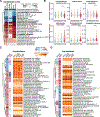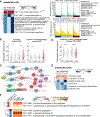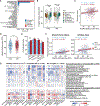Gut microbiome of multiple sclerosis patients and paired household healthy controls reveal associations with disease risk and course
- PMID: 36113426
- PMCID: PMC10143502
- DOI: 10.1016/j.cell.2022.08.021
Gut microbiome of multiple sclerosis patients and paired household healthy controls reveal associations with disease risk and course
Abstract
Changes in gut microbiota have been associated with several diseases. Here, the International Multiple Sclerosis Microbiome Study (iMSMS) studied the gut microbiome of 576 MS patients (36% untreated) and genetically unrelated household healthy controls (1,152 total subjects). We observed a significantly increased proportion of Akkermansia muciniphila, Ruthenibacterium lactatiformans, Hungatella hathewayi, and Eisenbergiella tayi and decreased Faecalibacterium prausnitzii and Blautia species. The phytate degradation pathway was over-represented in untreated MS, while pyruvate-producing carbohydrate metabolism pathways were significantly reduced. Microbiome composition, function, and derived metabolites also differed in response to disease-modifying treatments. The therapeutic activity of interferon-β may in part be associated with upregulation of short-chain fatty acid transporters. Distinct microbial networks were observed in untreated MS and healthy controls. These results strongly support specific gut microbiome associations with MS risk, course and progression, and functional changes in response to treatment.
Keywords: bioinformatics; gut microbiota; metagenomic sequencing; multiple sclerosis.
Copyright © 2022 Elsevier Inc. All rights reserved.
Conflict of interest statement
Declaration of interests The authors declare no competing interests.
Figures







Comment in
-
Team victory, yellow helmets for a computational tour de force.Cell. 2022 Sep 15;185(19):3459-3461. doi: 10.1016/j.cell.2022.08.013. Cell. 2022. PMID: 36113423 Free PMC article.
References
-
- Berer K, Gerdes LA, Cekanaviciute E, Jia X, Xiao L, Xia Z, Liu C, Klotz L, Stauffer U, Baranzini SE, et al. (2017). Gut microbiota from multiple sclerosis patients enables spontaneous autoimmune encephalomyelitis in mice. Proc Natl Acad Sci U S A 114, 10719–10724. 10.1073/pnas.1711233114. - DOI - PMC - PubMed
Publication types
MeSH terms
Substances
Grants and funding
LinkOut - more resources
Full Text Sources
Other Literature Sources
Medical

